Table of Contents[Hide][Show]
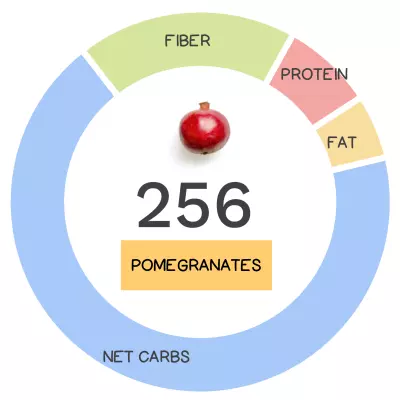
Pomegranates have been grown for thousands of years, originating in the Middle East, and are considered one of the five oldest cultivated fruits (others include olives, grapes, date palms and figs). In fact, fossilized remains of pomegranate leaves, branches and seeds date back to the early Bronze Age (3500 to 2000 BC) and there are references to pomegranate in both the Koran and Bible! Some scholars even believe pomegranate was the forbidden fruit eaten by Eve in the Garden of Eden! In many religions and cultures pomegranates have symbolic meaning representing abundance, fertility, prosperity, ambition, and good-luck and they have been used since ancient times for their medicinal properties. Pomegranates feature prominently in the mythology of the Egyptians, Romans, and Greeks and are represented in many major works of art. Archaeological remains have also been discovered in Egyptian tombs, indicating they were considered a luxury good. Domestication of pomegranates took place during prehistoric times, where it was introduced by sailors, missionaries and traders throughout the world and to the Americas in the 1500s. In the United States, pomegranates are now grown in California and Arizona.
Pomegranates are one of the five oldest cultivated fruits and have been grown for thousands of years!
Pomegranate, Punica granatum, is a long-living fruit-bearing deciduous tree with bright-red beautiful flowers. In fact, some pomegranate trees in France have survived for over 200 years! Sometimes used as ornamental trees owing to their beauty, in Japan dwarf varieties are widely used for bonsai as well. The name pomegranate literally translates to “seeded apple” from the Latin ‘pomum’ (apple) and ‘granatum’ (seeded). Interestingly, in French, the word for pomegranate is ‘grenade’ which is where the name for the military weapon derives from (guess they do have a similar appearance!). Botanically, pomegranates belong to the berry family since the seeds and pulp are produced from the ovary of a single flower. However, most of us wouldn’t classify it as such based on the culinary definition. The outside of the pomegranate is thick, leathery, and deep red in color. Inside is a thin-walled, white mesocarp that forms chambers that contain the edible arils – ‘jewel-like pearls of sweetness’, each carrying both juice and seed. The number of arils in a pomegranate can vary from 200 to 1400! Pomegranates are considered a super-fruit owing to their long-list of health benefits.
Nutrivore Score for Pomegranate – 256
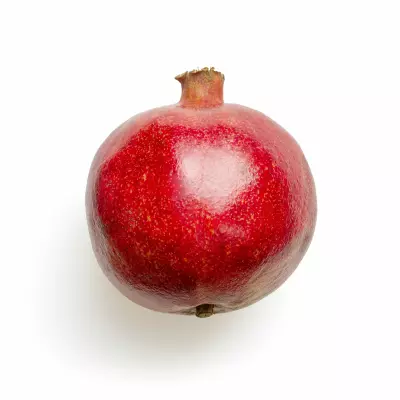
Pomegranate has a Nutrivore Score of 256, making it a medium nutrient-dense food! Plus, it is a low-fat food; pomegranate has 2.0 grams of fat per cup.
Per serving, pomegranate is a best source (>50% daily value) of polyphenols; an excellent source (20-50% daily value) of copper, dietary fiber, vitamin C, and vitamin K; and a good source (10-20% daily value) of vitamin B1 (thiamin), vitamin B5 (pantothenic acid), and vitamin B9 (folate).
Ditch Diets. Embrace Nutrients. Start with this FREE Guide.
Sign up for the free Nutrivore Newsletter, your weekly, science-backed guide to improving health through nutrient-rich foods — without dieting harder —and get the Beginner’s Guide to Nutrivore delivered straight to your inbox!

Pomegranate Nutrition Facts
One serving of pomegranate is standardized to 1 cup arils or about 174 grams (6.1 ounces). A typical pomegranate (4 inch diameter) weighs 282 grams which means: one pomegranate (4 inch diameter) is roughly equivalent to 1 1/2 servings of pomegranate.
Pomegranate Nutrition Facts Per Serving
| Pomegranate, raw | Nutrivore Score: 256 | Nutrient Density: Medium |
|---|---|---|
| Serving Size: 1 cup arils (174 grams) | Protein: 2.9 grams | Net Carbohydrates: 25.6 grams |
| Calories: 144 | Total Fat: 2.0 grams | Dietary Fiber: 7.0 grams |
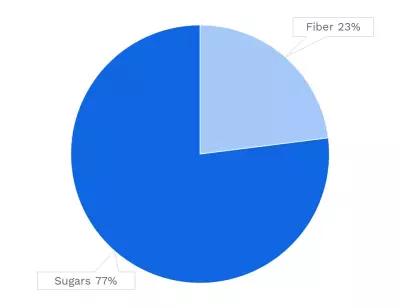

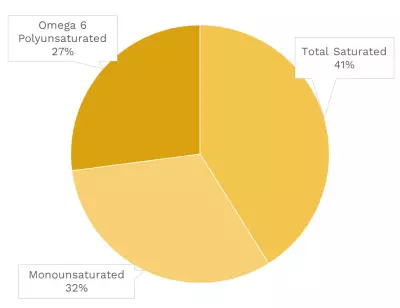
| VITAMINS | ||
|---|---|---|
| Vitamin A | 0.0 μg RAE | 0% DV |
| Vitamin B1 (Thiamin) | 116.6 μg | 10% DV |
| Vitamin B2 (Riboflavin) | 92.2 μg | 7% DV |
| Vitamin B3 (Niacin) | 0.5 mg | 3% DV |
| Vitamin B5 (Pantothenic Acid) | 0.7 mg | 13% DV |
| Vitamin B6 (Pyridoxine) | 130.5 μg | 8% DV |
| Vitamin B7 (Biotin) | ~ | ~ |
| Vitamin B9 (Folate) | 66.1 μg | 17% DV |
| Vitamin B12 (Cobalamin) | 0.0 μg | 0% DV |
| Vitamin C | 17.7 mg | 20% DV |
| Vitamin D (D2 + D3) | 0.0 μg | 0% DV |
| Vitamin E | 1.0 mg | 7% DV |
| Vitamin K | 28.5 μg | 24% DV |
| Choline | 13.2 mg | 2% DV |
| Myo-Inositol | ~ | ~ |
| CoQ10 | ~ | ~ |
| FUNCTIONAL FATS | ||
|---|---|---|
| MUFA | 0.2 g | 1% DV |
| ALA | 0.0 mg | 0% DV |
| EPA + DHA | 0.0 mg | 0% DV |
| CLA | ~ | ~ |
| Linoleic Acid | 0.1 g | 1% DV |
| MCT’s | 0.0 g | ~ |
| MINERALS | ||
|---|---|---|
| Calcium | 17.4 mg | 1% DV |
| Copper | 274.9 μg | 31% DV |
| Iodine | ~ | ~ |
| Iron | 0.5 mg | 3% DV |
| Magnesium | 20.9 mg | 5% DV |
| Manganese | 207.1 μg | 9% DV |
| Phosphorus | 62.6 mg | 5% DV |
| Potassium | 410.6 mg | 9% DV |
| Selenium | 0.9 μg | 2% DV |
| Sodium | 5.2 mg | 0% DV |
| Zinc | 0.6 mg | 6% DV |
| PHYTONUTRIENTS | ||
|---|---|---|
| Carotenoids | 0.0 μg | ~ |
| Polyphenols | 1240.8 mg | ~ |
| Phytosterols | 8.7 mg | ~ |
| Glucosinolates | ~ | ~ |
| Thiosulfinates | ~ | ~ |
| Betalains | ~ | ~ |
| AMINO ACIDS & PEPTIDES | ||
|---|---|---|
| Taurine | ~ | ~ |
| Ergothioneine | 0.0 mg | ~ |
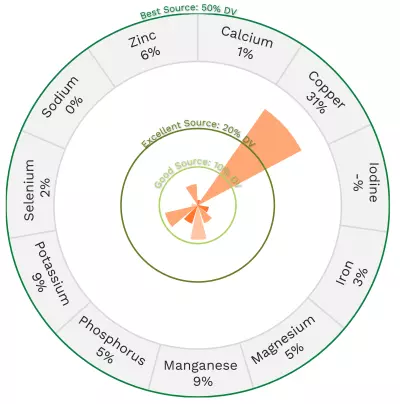
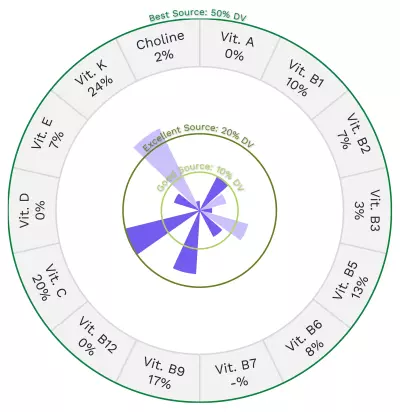
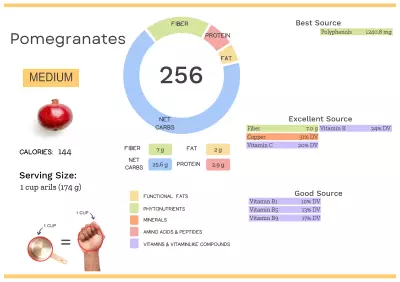
Pomegranate Nutrition Varies With Processing
The Nutrivore Score of pomegranate varies based on processing. For instance, pomegranate juice is widely available and is actually the main source of pomegranate consumption. Pomegranate juice has higher antioxidant levels than any other natural juice or commonly consumed polyphenol-rich beverage, such as green tea or red wine. Although juice delivers some of the good stuff pomegranates contain, each part of the fruit has its own unique profile of phytonutrients with corresponding health benefits. Studies consistently show a synergistic effect of all the different compounds contained within pomegranates, which means that greater benefits are obtained with the whole fruit as opposed to that seen when studying purified components individually. All that is to say, for maximum health benefits, try eating all of the pomegranate!
| NUTRIVORE SCORE | |
|---|---|
| Pomegranate, raw | 256 |
| Pomegranate juice, bottled | 148 |
Did all the nutrition in this fruit “POMp” you up? Maybe your friends will be impressed too.
Health Benefits of Pomegranate Nutrients
Let’s take a closer look at all of the best and excellent source of nutrients found in a 1-cup serving of pomegranate and see how they benefit our health.
Pomegranate Provides 1240.8 mg of Polyphenols
Pomegranate is a best source of polyphenols, providing a whopping 1240.8 mg of polyphenols per 1-cup serving!
The high number of polyphenols in this fruit makes pomegranates a strong and unique antioxidant with higher antioxidant activity than vitamins E, A or C.
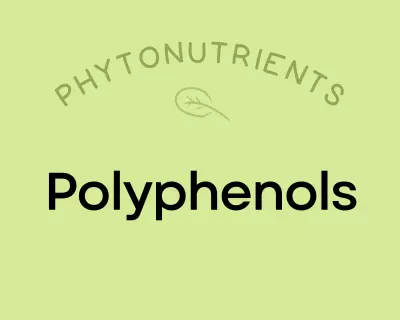
Polyphenols play a huge role in protecting against cancer, heart disease, diabetes, asthma, osteoporosis, neurodegenerative diseases, and other conditions associated with oxidative stress. In fact, a major reason foods like red wine and olive oil (as well as diets rich in both, such as the Mediterranean diet) show up as so beneficial may be due to their high polyphenol content! Along with chronic diseases, supplementing with polyphenols has been shown to protect against infections and reduce the signs of aging. Polyphenols exert their most potent effects by acting as antioxidants—preventing cellular damage by neutralizing hazardous oxygen radicals and improving cellular health as a result (which, in turn, benefits virtually every system in the body). As a result of their antioxidant properties, polyphenols also boost the immune system and protect against both chronic and acute diseases. In addition, polyphenols can help regulate enzyme function, stimulate cell receptors, modulate the functions of inflammatory cells (including T and B lymphocytes, macrophages, platelets, and natural killer cells), alter adhesion molecule expression, affect nerve cells and cardiac muscle cells, and exert antiviral effects. Learn more about polyphenols here.
Pomegranate Provides 31% DV Copper
Pomegranate is an excellent source of copper, providing 31% of the daily value per 1-cup serving!

Copper is a trace mineral that’s essential for all living organisms. Copper serves as a component of numerous enzymes and proteins in the body, giving it diverse roles in the growth, development, and maintenance of various organs (including the heart and brain), bone, and connective tissue. Copper is also involved in glucose and cholesterol metabolism, helps regulate gene expression, can scavenge free radicals, and is needed for the production of red blood cells. Learn more about copper here.
Pomegranate Provides 7.0 g of Fiber
Pomegranate is also an excellent source of dietary fiber, providing 7.0 g of fiber per 1-cup serving!

Fiber serves as substrate for the trillions of microbes that inhabit our digestive tracts, collectively referred to as the gut microbiome. Through their metabolism of fiber, these resident microbes benefit us in a whole host of ways, including aiding digestion, vitamin production, detoxification, regulation of cholesterol metabolism, providing resistance to pathogens, immune regulation, neurotransmitter regulation, regulation of gene expression, and more! In fact, every human cell is impacted by the activities of our gut microbes. A healthy gut microbial community is essential for our health. And, the converse is also true: An aberrant gut microbiome has been linked to conditions as wide-ranging as cancer, obesity, diabetes, cardiovascular disease, anxiety, depression, neurodegenerative diseases, autism, autoimmune disease, ulcers, IBD, liver disease, gout, PCOS, osteoporosis, systemic infections, allergies, asthma, and more!
Fiber has other benefits, like regulating peristalsis of the intestines (the rhythmic motion of muscles around the intestines that pushes food through the digestive tract), stimulating the release of the suppression of the hunger hormone ghrelin (so we feel more full), and slowing the absorption of simple sugars into the bloodstream to regulate blood sugar levels and avoid the excess production of insulin. Fiber also binds to various substances in the digestive tract (like hormones, bile salts, cholesterol, and toxins) and, depending on the type of fiber, can facilitate either elimination or reabsorption (for the purpose of recycling, which is an important normal function for many substances like bile salts and cholesterol), both of which can be extremely beneficial—if not essential—for human health.
The recommended dietary intake for fiber is 14 grams per 1000 kcal, which translates to 28 grams of fiber, if you eat a 2,000 calorie per day diet. However, there are many studies showing greater benefits from even higher levels of intake. Lear more about fiber here.
Pomegranate Provides 24% DV Vitamin K
Pomegranate is an excellent source of vitamin K, providing 24% of the daily value per 1-cup serving!
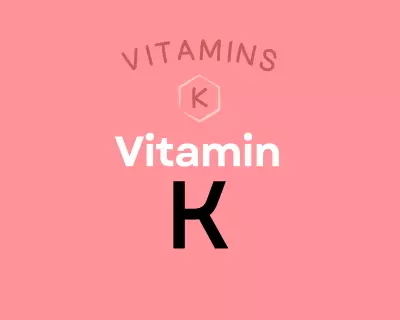
Vitamin K is actually a group of fat-soluble vitamins with a similar molecular structure, existing as K1, multiple isoforms of K2, and the synthetic form K3. This nutrient plays a vital role in coagulation, due to serving as a cofactor for proteins needed for blood clotting; it’s also essential for bone metabolism, cellular function, and the prevention of soft tissue calcification. Getting enough vitamin K2 can help protect against cardiovascular disease, may improve bone mineral density and skeletal health, and may even support endocrine function and brain health; there’s also some limited evidence it has anti-cancer and anti-inflammatory properties. Learn more about vitamin K here.
Pomegranate Provides 20% DV Vitamin C
Pomegranate is also an excellent source of vitamin C, providing 20% of the daily value per 1-cup serving!

Vitamin C is a water-soluble vitamin that has powerful antioxidant properties (meaning it can help combat oxidative damage from free radicals and reactive oxygen species) and that serves as an enzyme cofactor (meaning it’s needed for enzymes to do their job, for example vitamin C is necessary for collagen synthesis, which is essential for bones, joints, teeth, blood vessels, skin and eyes) and playing important roles in immune system and skin health. Higher intakes of vitamin C are linked to reduced risk of heart disease, some forms of cancer, type 2 diabetes, cataracts, age-related macular degeneration, and gout. Vitamin C can also help regulate the stress response and reduce anxiety, and there’s preliminary evidence that it may also help prevent Alzheimer’s disease. Learn more about vitamin C here.
Learn What Foods Are the Best Sources of Every Nutrient
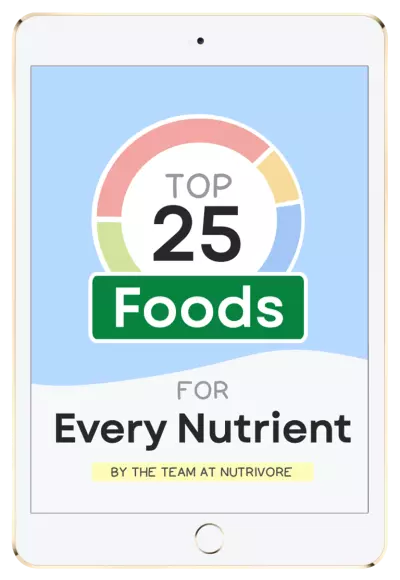
The Top 25 Foods for Every Nutrient
The Top 25 Foods for Every Nutrient e-book is a well-organized, easy-to-use, grocery store-friendly guide to help you choose foods that fit your needs of 43 important nutrients while creating a balanced nutrient-dense diet.
Get two “Top 25” food lists for each nutrient, plus you’ll find RDA charts for everyone, informative visuals, fun facts, serving sizes and the 58 foods that are Nutrient Super Stars!
Buy now for instant digital access.
How Much Pomegranate Should We Eat Per Day?
While it may seem like a lot of work to extract those ‘blood-red jewels of deliciousness’ from inside the leathery skin of a pomegranate, it is definitely worth the effort since pomegranates are one of the top super-foods for our health!
Eating two or three servings of fruit per day is optimal from a health perspective. A 2017 systemic review and meta-analysis looked at how all-cause mortality was impacted by varying intakes of 12 different food groups: whole grains and cereals, refined grains and cereals, vegetables, fruits, nuts, legumes, eggs, dairy products, fish, red meat, processed meat, and sugar-sweetened beverages. This analysis revealed non-linear relationships between how much of a particular food group we eat and how it impacts our health. While the results revealed no upper limit to the benefits of vegetable intake, the sweet spot for fruit intake was 300 grams daily. Intakes of fruit over 400 grams per day were not as beneficial as 300 grams, but the good news is that even intakes of 600 grams of fruits per day was superior to no fruit at all! This sweet spot for fruit intake translates to 2 to 3 servings of fruit daily.
And a 2018 review similarly concluded that two to three servings of fruit daily was optimal for reducing risk of cardiovascular disease, type 2 diabetes, obesity, chronic obstructive pulmonary disease, chronic constipation, and inflammatory bowel disease.
Fruit makes a convenient snack, a healthy dessert, a whimsical addition to salads, and a sophisticated flavoring agent in the form of salsas, jams, and chutneys. A serving is standardized to 1 cup chopped for raw vegetables and fruits (typically translates to 1/2 cup to 2/3 cup once cooked). Learn more in Importance of Vegetables and Fruit
Pomegranates are cardioprotective, neuroprotective, and osteoprotective, as well as protecting against cancer, diabetes, inflammation disorders and more!
It’s always best to mix up the fruit and veggies you eat day to day (aiming for a wide variety of different vegetables and fruits throughout the week), and pomegranate definitely has a place at the table.
Easily track your servings of Nutrivore Foundational Foods!

The Nutrivore Weekly Serving Matrix
The Nutrivore Weekly Serving Matrix digital resource is an easy-to-use and flexible weekly checklist designed to help you maximize nutrient-density and meet serving suggestions of Nutrivore foundational foods, all without having to weigh or measure your foods!
Includes a 22-page instructional guide and downloadable interactive guides.
Buy now for instant digital access.
cITATIONS
Expand to see all scientific references for this article.
Ghasemnezhad M, Zareh S, Shiri MA, Javdani Z. The arils characterization of five different pomegranate (Punica granatum) genotypes stored after minimal processing technology. J Food Sci Technol. 2015 Apr;52(4):2023-32. doi: 10.1007/s13197-013-1213-6. Epub 2013 Dec 3. PMID: 25829582; PMCID: PMC4375177.
Halliwell B, Cheah IK, Tang RMY. Ergothioneine – a diet-derived antioxidant with therapeutic potential. FEBS Lett. 2018 Oct;592(20):3357-3366. doi: 10.1002/1873-3468.13123. Epub 2018 Jun 15. PMID: 29851075.
USDA Food Central Database: Pomegranates, raw


